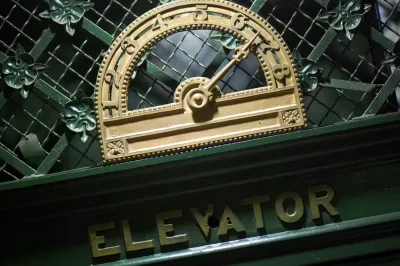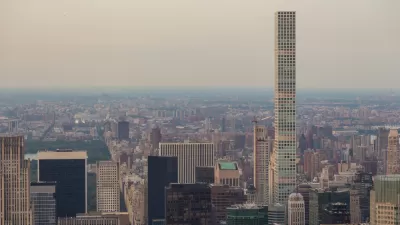Moving an 80,000-pound metal box means using energy, and elevators can account for 2-10% of a buildings energy use.

There are about 7.6 billion people on earth and, according to Smithsonian Magazine, those people take more than 7 billion elevator trips every day. That vertical movement costs energy and the need adds up quickly. "Newer elevators already incorporate green features such as LED lights, water soluble paint and recycled construction materials, but many companies have begun to explore a wide and somewhat outlandish array of alternatives to the traditional rope-and-pulley systems of a hundred years ago," Adrienne Bernhard reports for the Smithsonian Magazine.
An elevator can weigh 4 tons, consuming energy even when it's not in use. "In fact, elevators typically account for between 2 percent and 10 percent of a building’s energy use," Bernhard reports. But regenerative drive systems that reclaim some of the energy they use has cut into that energy cost for some new elevator designs. There are also machine room-less elevators, which allow for flat roofs, that are easier to use for solar power generation. "In 2017, Thyssenkrupp Elevator became the first company to retrofit an existing elevator to achieve net-zero energy," Bernhard writes.
FULL STORY: Elevators Are Going Green

Alabama: Trump Terminates Settlements for Black Communities Harmed By Raw Sewage
Trump deemed the landmark civil rights agreement “illegal DEI and environmental justice policy.”

Planetizen Federal Action Tracker
A weekly monitor of how Trump’s orders and actions are impacting planners and planning in America.

How Atlanta Built 7,000 Housing Units in 3 Years
The city’s comprehensive, neighborhood-focused housing strategy focuses on identifying properties and land that can be repurposed for housing and encouraging development in underserved neighborhoods.

In Both Crashes and Crime, Public Transportation is Far Safer than Driving
Contrary to popular assumptions, public transportation has far lower crash and crime rates than automobile travel. For safer communities, improve and encourage transit travel.

Report: Zoning Reforms Should Complement Nashville’s Ambitious Transit Plan
Without reform, restrictive zoning codes will limit the impact of the city’s planned transit expansion and could exclude some of the residents who depend on transit the most.

Judge Orders Release of Frozen IRA, IIJA Funding
The decision is a victory for environmental groups who charged that freezing funds for critical infrastructure and disaster response programs caused “real and irreparable harm” to communities.
Urban Design for Planners 1: Software Tools
This six-course series explores essential urban design concepts using open source software and equips planners with the tools they need to participate fully in the urban design process.
Planning for Universal Design
Learn the tools for implementing Universal Design in planning regulations.
Caltrans
Smith Gee Studio
Institute for Housing and Urban Development Studies (IHS)
City of Grandview
Harvard GSD Executive Education
Toledo-Lucas County Plan Commissions
Salt Lake City
NYU Wagner Graduate School of Public Service





























